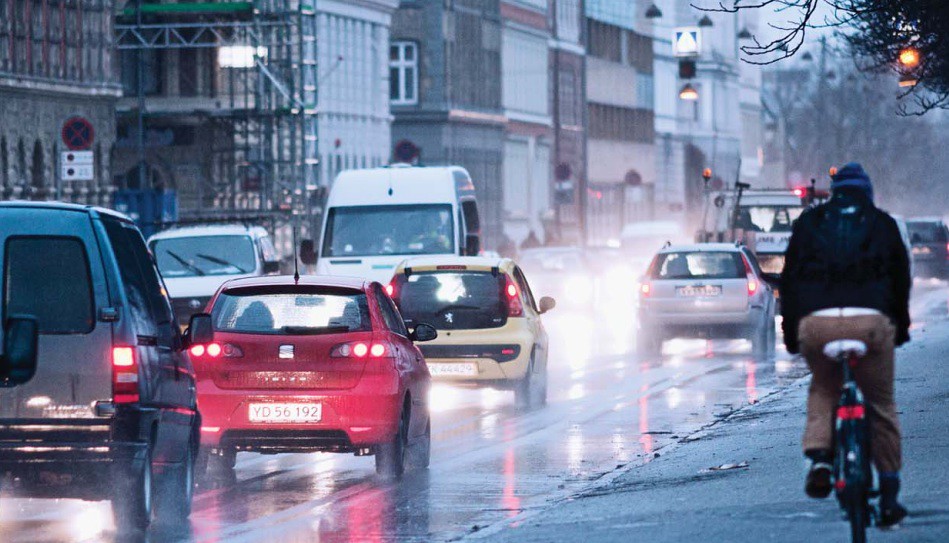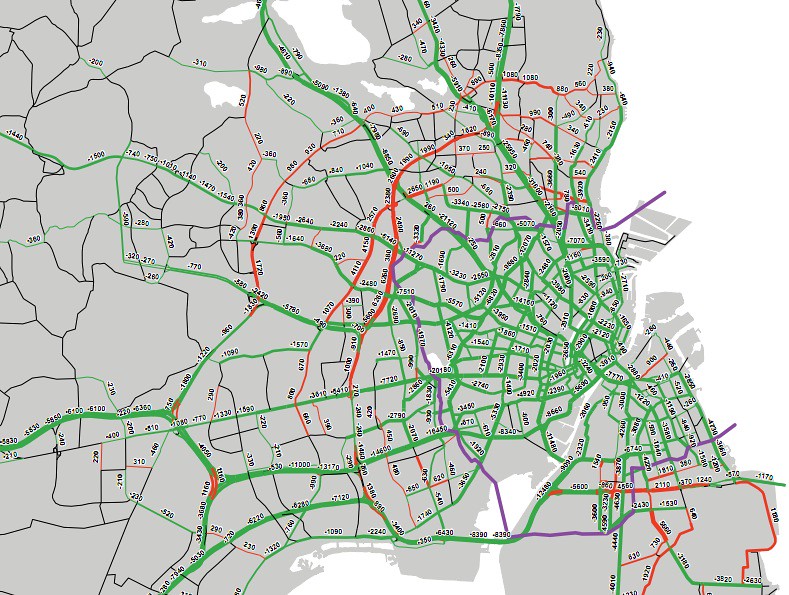
Right now the Danish minister of transport is finalizing the law proposal for the Copenhagen Congestion Ring.
 |
|
Visualization of the congestion ring control/payment system, from the report by the Danish Road Authority (Vejdirektoratet), TRÆNGSELSAFGIFT I HOVEDSTADEN, Miljøundersøgelse |
At the moment the discussion between the coalition government parties is centered on how much should be charged outside rush hour. The Social Democrats and The radical Left (which is a center party, and not at all radical in any way) seem to believe congestion is something which only happens between 7 and 9 in the morning, and 3 and 5 in the afternoon. Which is factually wrong, first of all even on sunday afternoons we have large cross town streets, where cars cue bumper to bumper, intersection to intersection, in both directions, even though there are no particular happenings, like a ball game or something.
Congestion is also when every f...... street is lined with cars, and cars, and cars, squeezing all life out of the neighborhood.
When the noise is so loud people actually die in hundreds, and the in thousands from the emissions, every year.
Trouble is, during the election, the spin doctors found that all the benefits of the congestion ring, which was at that time called the "toll ring", no matter haw you construe it, are to many to be communicated effectively. The loss of peoples time in car-cues, they found, was plenty of ammo needed to justify it, and now the politicians don´t care about the full reasoning of the toll ring, its just about reducing time people waste in a cue. Essentially a great case about the stupidity of modern politics. "We only regulate, what we can communicate". Who cares about what the society needs.Interestingly in relation to this, the city released a new research on citizen happiness with living in the city, the top-10 wishes was better public transportation(50% said this), less traffic/noise (38%) better bike lanes, bike racks etc. (31 & 16%), better parks/green areas (26%) and more affordable housing (25% & 17%), lower tax (12%) (Copenhagen is one of the lowest tax cities in DK, but danes always complain) came at 15, and better car parking at 17th place (13%). Still even the far left politicians are afraid of how they will be punished by the car-vote.
 |
|
A picture of speed, dynamics and economic growth -to some! |
About half of the worst streets, which exceed the EU norms, will fall below the EU norms. The Congestion ring is the best news to reach copenhagen lungs, since the new smoking laws, and keep in mind, twice as many die from car emissions, as do from passive smoking. This is really something that counts.
The report also finds that the most preferred alternative to driving your car, is to carpool, and close following to bike. Each replacing about a third of the declined trips in own car. the last third will choose to either not go at all (1/6) and the last sixth of the people who will leave the car at home, will choose public transportation.
This is great from several perspectives, financially the ring will give an extra earnings of about € 200 mill. a year. The increase in efficiency of public transportation, will to a large degree absorb the growth in travellers. The London busses increased efficiency by 20% after their congestion ring was established.
This does not mean, investments in public transportation, especially on rails, should not be followed through. Particular the train commuters from larger cities in the Region, such as Roskilde, Køge and Helsingør, suffer from poor service today, and only busses benefit from less car traffic.
Even after the Congestion ring, only an estimated 9% of the trips will be by bus, suggesting that busses are the last resort of commuters. A conversion on the main arterial lines to bus rapid transfer or light rail, would likely help change both image and travel times for the passengers, who are in volumes to be found on about five primary bus routes, including line 5A, the most travelled busline in northern Europe.
But as the numbers above indicate, the bicycle infrastructure, the cheapest of all commuter solutions, is imperative to improve. This is all initial changes, and I bet the people who says they will carpool, will eventually gravitate towards bikes and public transportation, as one of the primary motivators of driving a car is the individuality, and carpooling is in reality
My analysis of the current choices of mode of transportation and the change pattern, the road authority researched, suggest that around 40% of all commuters will travel by bike, and only half, 21%, by car. Almost 50% of the commuters will travel without use of any kind of engine.
In my mind this is incredible, the establishment of a congestion ring will be a defining moment in the history of Copenhagen.
At the same time it exposes the lacking coherence in the strategy and the applied means of the city politicians, in reaching the 2015 goal of 50% commuters travelling by bike. It should be obvious, that you can not outspend cycling initiatives by a factor of four in favour of car parking, and expect cyclism to grow. Even with a congestion ring, the city is only half way meeting its objective of 50% cyclist in 2015.
Strangely, while many of us understand cycling and public transportation as equal and democratic mobility, it is the Social Democrats who delivers the majority and deciding mandates for the car-centric policies.
Even more strange it is to see that Frank Jensen, the lord mayor of Copenhagen, a Social Democrat himself, and the architect behind the car centric policies, never talks about his “wonderful” car policies, but always about the Copenhagen the bike-city, a concept he actively works against.
The change will eradicate the need for a high share of the existing parking spaces in the city, giving more space to bike lanes. The need for more than one car lane in each direction will also be reduced and many lanes can be dedicated for better bus service or even better, for a light rail network, which increase traffic capacity ten-fold and drastically reduces noise and air pollution. Light rail being extremely predictable, it either moves along its track or it stops, no unforeseen turns, will also likely reduce traffic accidents. Research does not support this though, which merely suggests light rail is as safe or unsafe as city busses.
/P%C3%A5_vej_til_arbejde_med_cyklen_og_S-toget.jpg) One of the three parties of the left-center coalition government, concluded that, as such a high number converted from car to bike, some of the revenues of the congestion ring should fund a bicycle superhighways network.
One of the three parties of the left-center coalition government, concluded that, as such a high number converted from car to bike, some of the revenues of the congestion ring should fund a bicycle superhighways network.
The sudden change will be extremely interesting to follow. The research suggests a high share will car-pool, I doubt this will last, and predict that most will either go back to using their own car, or start using public services or their bike, cars are perceived as the most individual and independent mode of transportation, as well as having badge value, carpooling has neither, to an extreme.
Public transportation is probably undervalued. If you are used to drive your own car, public carries a lot of prejudices which are really not true, specifically in combination with bicycles, it becomes really fast and is really probably as reliable as your own car, no parking trouble, and though we get a fair share of rain, it will rarely coincide with your commute.Will an 80% no-car commuting society tip the scale finally, and be enough to really make the big changes in the city landscape. I REALLY HOPE SO!
 |
|
The profits of the Congestion ring will fund better public transportation and bikeablity. Photo by the Danish Road Authority, Vejdirektoratet. |






